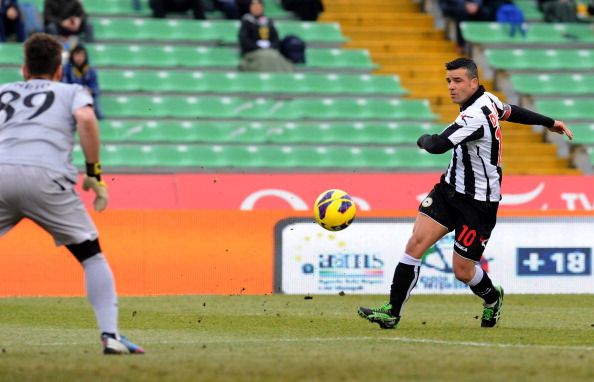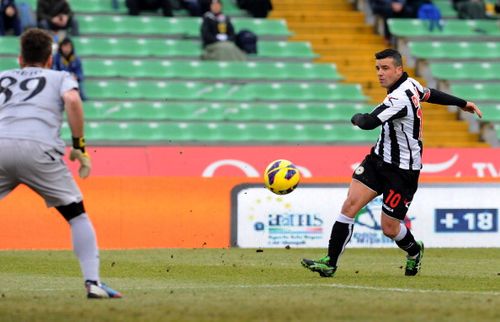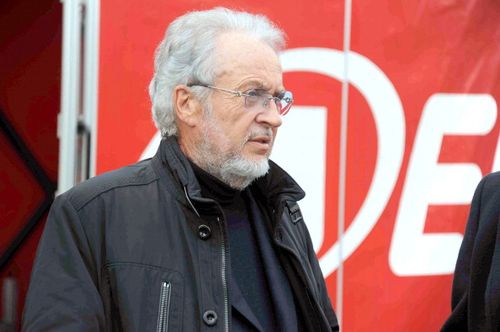
Udinese, Granada and Watford: Pozzo's Italian Job

Udinese Calcio, the second oldest Italian football club, are perhaps more famous for stellar names such as Alexis Sanchez and Antonio di Natale. Coming on the back of a brilliant 2011-12 campaign that saw the Bianconeri clinch third on the final day of the season and with it, a Champions League berth for a second successive season, much was expected of the side led by Francesco Guidolin. The departure of key personnel Kwando Asamoah and Mauricio Isla now sees the Italian side placed 9th in the Serie A, unable to replicate the highs of the previous season.
On the other side of Europe, the Andalusian-based Granada F.C. are relatively safe in the La Liga, having secured successive promotions from the Segunda B, Spain’s third tier of league football. While fans would hope their side can improve on their current position, they can be forgiven for not having more lofty ambitions, given that Granada were on the verge of shutting shop in 2009 before the owners of Udinese, the Pozzo family, stepped in and dramatically changed their fortunes.
The two clubs have since formed a unique, almost symbiotic partnership. The agreement, signed in July 2009, meant the majority of Granada’s squad would become Udinese-owned, while the Italian club could also send over its reserves and youngsters. Simply put, this partnership rendered Granada a development club, an Udinese B if you prefer. And the financial benefits of the partnership are fairly straightforward. The Spanish league side is used as a window to showcase Udinese-owned talent that will, in turn, rise in value in the transfer market.

Giampaolo Pozzo, owner and president of Udinese
Being a provincial-based club, Udinese do not possess the financial muscle to rival clubs like Inter, Juventus or Milan. When Giampaolo Pozzo bought the the club some 25 years ago, he devised an innovative solution to keep the club in the top division while remaining profitable at the same time. Pozzo set up a scouting network of fifty scouts spread across the globe with hundreds more local contacts in order to identify the most promising young players before they had become fully established. Focusing more on the second-tier nations in Africa and South America enabled the club to sign youngsters at a reasonable price. Their ability to find hidden talents all over the world, which they develop and later sell for large profits, has helped the club turn in profits in excess of 100 million Euros over the past decade. The most striking success of this policy was the transfer of forward Alexis Sanchez. The Chilean was signed as a 16-year-old for €2m and later sold to Barcelona for a princely sum of €26m (plus €11m in add-ons).
It is here that the arrangement between Udinese and Granada reaps dividends for both sides. Udinese’s vast scouting network means the Italian side have a glut of players on their books. In fact, Udinese currently have in excess of 60 players in their squad. Such a number necessitates a significant amount of players being sent out on loan every season. While most would consider Granada to be a feeder club, they are, in fact, a direct beneficiary of the Italians’ surpluses. This arrangement also works well for the players – they earn valuable experience at Granada and give the Italians a crop that is either good enough to play or valuable enough to sell for big profits.
Indeed, Granada’s successive promotions from the third-tier to the La Liga were largely built on the loans from Udinese. At a time when they were saddled with crippling debts and faced with the prospect of closing down, the agreement between the Pozzo-led clubs has proved fruitful for all parties involved. In the first season of the partnership, a staggering ten players were sent to the Andalusian side. That influx of talent helped propel the side into the Segunda, Spain’s second division, behind Pep Guardiola’s Barcelona B.
The following season saw the arrival of more players from the Italian side. The owners, keen not to alienate the passionate El Graná, developed a potent concoction of experienced Spanish players complemented by the young talent inherited from Udinese’s reserve and fringe pool. The play-off semifinal against Celta Vigo featured 6 Udinese owned players in the starting eleven. Granada’s subsequent promotion to the La Liga was proof that the strategy employed by Giampaolo Pozzo was paying dividends to both clubs. The club survived their first season in the top division thanks to their loan stars, finishing 17th, while the 2012-13 season sees them in a relatively safer position, 14th, and 6 points away from the drop zone.

Granada CF supporters cheer their team
While a lot of clubs in the lower divisions have cried foul at Granada’s roster of loanees, the agreement is entirely legal and compliant with FIFA’s rules. A fact that just goes to show the astute shrewdness of the man, Giampaolo Pozzo. Having consolidated his position in Spain, Pozzo then turned to England where he acquired the Championship side Watford F.C. who were on the brink of administration. Like Granada in Spain, Watford have been beneficiaries of the change in ownership. Indeed, the Hertfordshire-based club are currently placed third in the Championship and are assured of a berth in the playoffs, their lofty position only helped by the ten loan players they have on their books – eight from Udinese and the other two from Granada.
A unique, almost revolutionary path to financial success and stability, even if some would call it a blatant exploitation of FIFA regulations, one wonders if this is a path that the big clubs will look to tread on in the future. Indeed, if Watford manage to get promotion to the Premier League, it would, in effect, amount to three Udinese sides playing in the top division of three of the top leagues in Europe. An unbelievable and staggering achievement. And credit must go to the vision of Giampaolo Pozzo – the man who has pulled off an Italian Job.